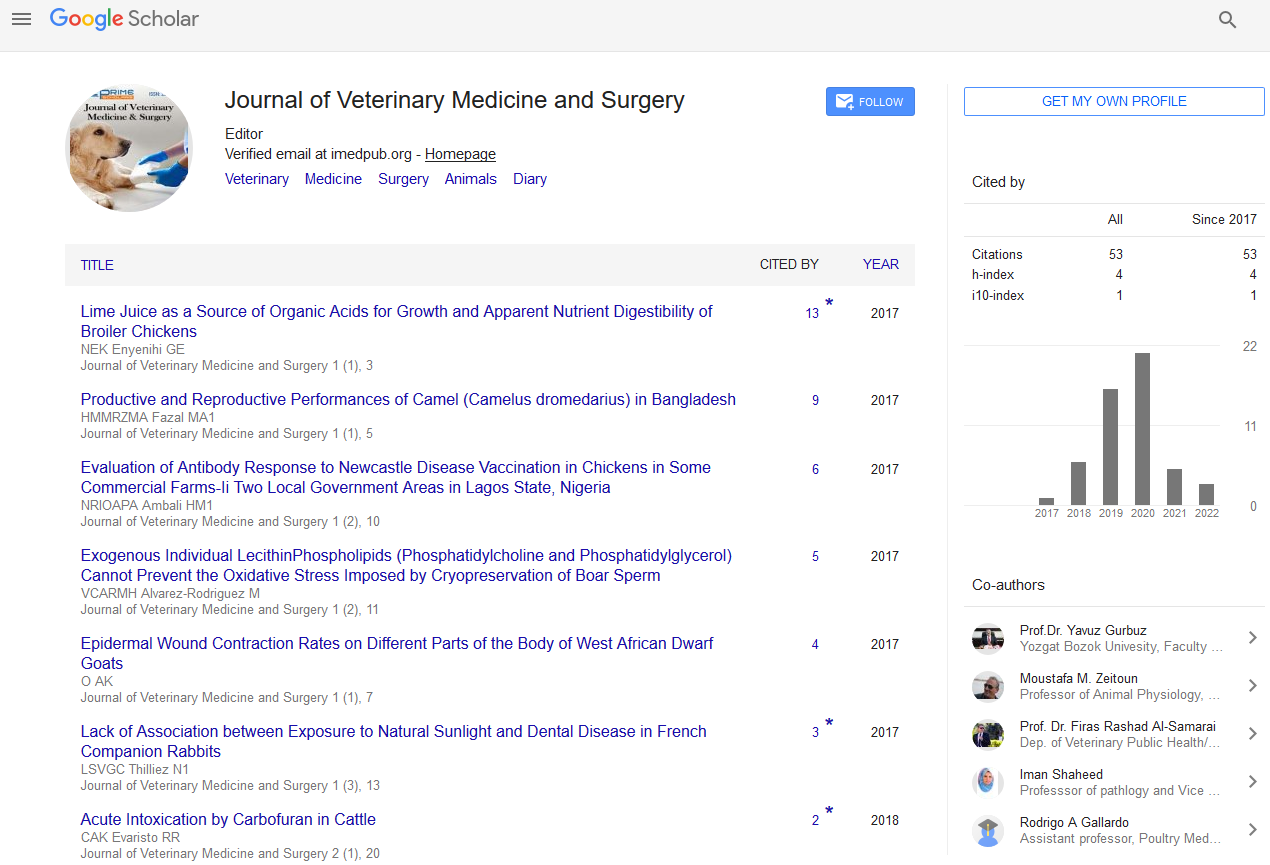Short Communication - (2024) Volume 8, Issue 2
Spaying and Neutering in Animals: Benefits, Procedures, and Considerations
Emily Casen*
Department of Veterinary Science, University of California, USA
*Correspondence:
Emily Casen,
Department of Veterinary Science, University of California,
USA,
Email:
Received: 29-May-2024, Manuscript No. IPJVMS-24-20549;
Editor assigned: 31-May-2024, Pre QC No. IPJVMS-24-20549 (PQ);
Reviewed: 14-Jun-2024, QC No. IPJVMS-24-20549;
Revised: 19-Jun-2024, Manuscript No. IPJVMS-24-20549 (R);
Published:
26-Jun-2024, DOI: 10.36648/2574-2868.8.2.11
Introduction
Spaying and neutering are common surgical procedures
performed on animals to prevent them from reproducing.
Spaying refers to the removal of the ovaries and usually the
uterus in female animals, while neutering, or castration,
refers to the removal of the testicles in male animals. These
procedures have become standard practices in veterinary
medicine, offering numerous benefits for individual animals
and the broader community. This article explores the
importance, procedures, benefits, and considerations of
spaying and neutering in animals. Spaying and neutering are
crucial in managing the pet population and preventing the
overpopulation crisis. Millions of animals enter shelters each
year, and many of them are euthanized due to a lack of homes.
By preventing unwanted litters, spaying and neutering reduce
the number of animals that end up in shelters, ultimately
lowering euthanasia rates. Spaying and neutering offer a wide
range of benefits beyond controlling the pet population. These
benefits include health improvements, behavioral changes,
and societal advantages. Spaying female animals eliminates
the risk of ovarian and uterine cancers and significantly reduces
the risk of mammary gland tumors, especially if done before
the first heat cycle. Neutering male animals prevents testicular
cancer and reduces the risk of prostate diseases. Pyometra is a
life-threatening uterine infection common in older [1,2].
Description
Neutered males are less likely to display aggressive behaviors
and are less prone to roaming in search of females, which
reduces the risk of injuries and accidents. Neutering males and
spaying females can significantly reduce or eliminate marking
and spraying behaviors, making pets more pleasant to live with.
Spaying and neutering can reduce excessive vocalization related
to mating behaviors, such as howling and yowling in cats. By
preventing unwanted litters, spaying and neutering reduce the
number of animals entering shelters and, consequently, the
number of animals euthanized due to lack of homes. Spaying
and neutering can save pet owners money in the long run by
preventing costly health issues and reducing the likelihood of
injuries and accidents related to mating behaviors. Reducing the
number of stray animals through spaying and neutering helps
decrease the spread of zoonotic diseases, such as rabies and
parasites, improving overall community health. Spaying and
neutering are surgical procedures that should be performed by
a licensed veterinarian under general anesthesia. The animal is
given general anesthesia to ensure it is unconscious and painfree
during the procedure. Castration involves the removal
of the testicles in male animals. Post-surgical care is crucial
to ensure a smooth recovery and minimize complications.
While there is a cost associated with spaying and neutering,
many communities offer low-cost or subsidized programs to
make these procedures affordable [3,4]. The long-term health
benefits and prevention of unwanted litters often outweigh the
initial cost.
Conclusion
Spaying and neutering are vital procedures in veterinary
medicine that offer significant benefits for individual animals
and the broader community. These surgeries help control the
pet population, reduce the risk of certain health issues, and can
lead to better behavior and improved quality of life for pets.
Understanding the procedures, benefits, and considerations
can help pet owners make informed decisions that contribute
to the well-being of their animals and the community at large.
Acknowledgement
None.
Conflict Of Interest
None.
References
- Urfer SR, Kaeberlein M (2019) Desexing dogs: A review of the current literature. Animals (Basel) 9(12):1086.
[Crossref] [Google Scholar] [PubMed]
- Howe LM (2015) Current perspectives on the optimal age to spay/castrate dogs and cats. Vet Med (Auckl) 6:171-180.
[Crossref] [Google Scholar] [PubMed]
- Vendramini THA, Amaral AR, Pedrinelli V, Zafalon RVA, Rodrigues RBA, et al. (2020) Neutering in dogs and cats: Current scientific evidence and importance of adequate nutritional management. Nutr Res Rev 33(1):134-144.
[Crossref] [Google Scholar] [PubMed]
- Valtolina C, Vaandrager AB, Favier RP, Tuohetahuntila M, Kummeling A, et al. (2017) Sex specific differences in hepatic and plasma lipid profiles in healthy cats pre and post spaying and neutering: Relationship with feline hepatic lipidosis. BMC Vet Res 13(1):231.
[Crossref] [Google Scholar] [PubMed]
Citation: Casen E (2024) Spaying and Neutering in Animals: Benefits, Procedures, and Considerations. J Veterinary Med. 8:11.
Copyright: © 2024 Casen E. This is an open-access article distributed under the terms of the Creative Commons Attribution License, which permits unrestricted use, distribution, and reproduction in any medium, provided the original author and source are credited.

